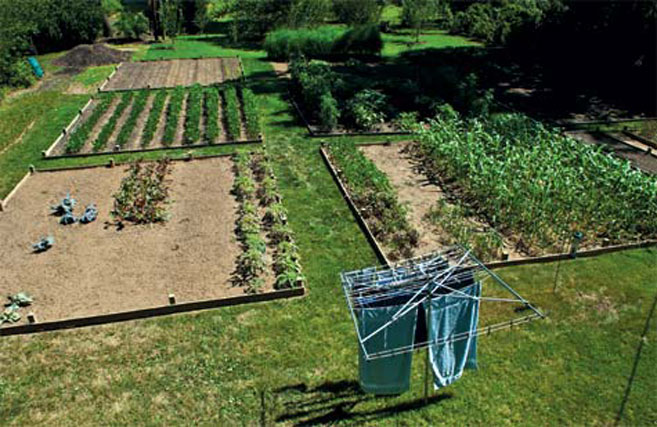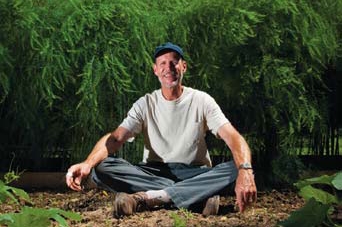As They Sow, So They Reap
Faithful family feels call to grow and share fresh food
Jack and Maggie Jezreel were in a hurry when they were shopping for houses in Louisville 12 years ago. Maggie wanted to study massage and craniosacral therapy, and their daughters needed to enroll in school. The Jezreels had lived near Louisville for many years but didn’t have a sense of where in the city they wanted to end up. But one thing they knew for sure: They wanted space to grow food — and plenty of it. So their directions to the realtor were brief, Jack says: “Find something with half an acre.”
The family had lived in Spencer County, growing produce organically to sell by subscription to the folks at Church of the Epiphany, where Jack worked. Later they lived on a farm in Washington County, without running water, electricity or a telephone.
This time they ended up on a quiet street off Westport Road with a tall tree canopy and a 100- by 200-foot lot with a deep, wide, flat backyard.
The Jezreels lived there quietly for eight years as the girls went through school and Maggie started her business. Meanwhile, Jack, who holds a master of divinity degree from the University of Notre Dame, “started a little nonprofit”: JustFaith Ministries, designed to help members of Catholic parishes expand their commitment to social ministry. The work required him to travel sometimes 100 times a year, and the organization grew quickly to 15 employees. In the meantime, he was diagnosed with cancer, and started consuming only plantbased foods.
Four years ago, “as we got closer to an empty nest,” he says, Jack broke ground on three 24- by 24-foot garden plots in his backyard and planted three pawpaw trees in the front. Pawpaw trees, which grow a luscious, tropical-tasting fruit, are indigenous to Eastern North America forest understory, so they grow well in the dappled shade of two towering oak trees that dominate the Jezreels’ front yard. The next year “I took advantage of my soonto- be son-in-law” to put in six additional beds, he says.
Down the west side of their backyard is a long row of blackberries and black raspberries. Across the back of the yard are fruit trees: three apple, three cherry, two peach and three Asian pear trees. A long asparagus patch yields much more than the Jezreels can eat. Seven bushes lining the driveway allowed them to pick 30 gallons of berries for freezing and countless quarts for giving away, but the Jezreels can eat them all before next season. Dwarf blueberry bushes, two Carmine Jewel cherry trees grow along the curved front walk, with low cranberry plants creating a pretty groundcover that turns red in the fall. Two fig trees, planted this past spring on either side of the driveway entry, yielded fruit in just a few months. “I try to pick [plants] that look OK in the front yard,” says Jack.
Jack says the suburban fruit grower must steel himself (or herself) to be “frustrated by fuzzy creatures.” Jack’s heavily composted beds — he has eight cubic yards of compost delivered every other month — makes easy going for moles. Voles, rabbits, squirrels, raccoons and possums are common and can wreak havoc. Of the 30 to 50 fruits that each pawpaw tree yields, “I might get half of those,” he says. His latest effort to keep critters away from fruit — and from his sweet corn — is blood meal, a high-nitrogen soil amendment that he has sprinkled around some of his plants.
After the backyard vegetable plots were dug and amended and planted, Jack began adding cedar boards to the sides to create more definite raised beds. Each bed has wide mounds for garden plants, with 1½-foot-wide paths in between. These paths allow Jack to avoid walking on the mounds, which would compact the soil.
Over the years, the Jezreels have changed what they grow. “I’m not retired,” says Jack. “I [garden] when I can.” One entire bed is dedicated to black beans for drying. “They are very easy,” says Jack. The beans dry when they’re on the plant. “I can leave them for a long time” and pick when it’s convenient. Then the couple puts in a movie and shucks the beans as they watch. Similarly, one entire bed grows sweet potatoes. Digging them is “a day-long project but it’s just one day,” he says. The potatoes are cured on sheets in the house, then stored to eat for the next five months or so. White potatoes of various kinds also provide food through much of the winter.
“The agreement with Maggie and me is I don’t make work for her,” says Jack, though both Maggie and Jack monitor the berries, which require picking every other day to stay current. But the 24-foot rows of green beans had to go. Green beans not only have to be picked day in and day out, but excess often requires elaborate preservation — pressure canning or blanching and freezing. Now there’s an eight-foot row of green beans for eating fresh. There are just two zucchini plants. Turnips, radishes and daikon, grown once, have not returned. “I don’t grow pickling cucumbers,” he adds. If he can’t keep the raccoons away from the sweet corn, it, too, may have to go.
Though the Jezreels store potatoes, sweet potatoes, winter squash, onions and black beans, there is fresh food for much of the year. Starting early with lettuce, peas and spinach, beds are amended with compost and re-used later in the season for late broccoli, cabbage and cauliflower. Beets, tomatoes and cherry tomatoes, eggplant, peppers, carrots, leeks, garlic and kale are some of the annual crops that get rotated through.
“I think about what would be good food for a guy who has had cancer.” Color, says Jack, is the key to health. The more varied the color, the more varied his phytochemical intake.
His own interest in the garden “is evolving,” he says. “I want the garden to be more interesting than just neat rows with no weeds.”
Some of that evolution is happening. After 12 years of living on the property, he spotted his first box turtle in the blackberry patch. A juvenile Cooper’s hawk recently hopped through the sweet potatoes. “Pawpaws [are] the only thing that a Zebra Swallowtail butterfly eats as a caterpillar,” he says, “and the Zebra Swallowtail butterfly is absolutely beautiful.”
“I’m trying to anticipate how climate change is going to affect the garden,” he says. Hotter weather and harder rainfall will require him to adjust, including drip irrigation. He wants to plant a refuge for butterflies, and for the runners and walkers who frequent his shady street. He thinks about a gentler transition between house and garden, and about how he can take advantage of the beauty of food crops.
Lawns, Jack points out, evolved as a sign of wealth. Wealthy people could afford lawns because they didn’t need to use all their space to grow food — and like eating white bread in Europe or white rice in Asia, the bourgeoisie couldn’t wait to emulate the wealthy. “I like the idea of using my yard this way,” says Jezreel, after noting that he grows more than they can eat. “Societally, we have denigrated using our body for work. There’s pleasure in it, if you use your body for a productive purpose.” And Jack is living proof of that.
RECIPES
Quinoa with Corn, Peppers and Cilantro
MAGGIE’S FALL GARDEN MELANGE
Ingredients
- 2 tablespoons oil
- 1 onion, chopped (about 1 cup)
- 1 red or green pepper, chopped
- 3 large cloves garlic,
- chopped (about 1 tablespoon)
- 1¾ cup cooked (or canned) black beans,with liquid
- 6 large kale leaves, stripped off their stems and chopped
- 1 cup corn (fresh or frozen)
- 1 large sweet potato, cubed
- 1 to 2 tablespoons chili powder
- 1 teaspoon ground cumin
- ½ teaspoon dried oregano
Instructions
- Salt and pepper to taste
- Heat oil in a deep, wide, heavy pot over medium-high heat. Add onion and pepper and cook about 5 minutes, stirring occasionally. Add garlic and cook, stirring a few times, about 5 minutes more.
- Add remaining ingredients, reduce heat to medium and cook, stirring occasionally, until sweet potatoes are cooked through. Add a little water as necessary if vegetables start to stick to the pan.
- Serve over rice with fresh cilantro and salsa.
CREAMY CARROT DRESSING
Ingredients
- ¼ cup oil
- 1 carrot, diced
- 1 tablespoon sesame seeds
- 1 tablespoon peanuts
- 1 clove garlic
- 1 tablespoon soy sauce
- ⅓ cup sour cream
Instructions
- Combine oil, carrot, seeds, nuts, garlic and soy sauce in a blender or food processor and blend until smooth. Add yogurt and blend briefly.
- Use on leafy salad or on other cold vegetables. Makes about ¾ cup.
Jack Jezreel’s recommendations:
Jack has always gardened organically and virtually all by hand, so tools are important to him. He doesn’t use a rototiller, to avoid hardpan and soil compaction. His most common soil amendment is constant application of huge amounts of compost that he buys from Earth First.
These are his other go-to suppliers:
- Fresh Start Grower’s Supply: Jack buys organic inputs for his garden — for corn and some of the fruit-bearing plants. He likes the Fertrell products, among other items, at Fresh Start in Louisville.
- Gardens Alive: This store, in Lawrenceburg, Indiana, can be “a little pricey,” says Jack, but they have good sales and good products.
- Johnny’s Selected Seeds: This mail-order catalog from Maine provides “a lot of my tools and some of my amendments, and they have very high quality seed,” says Jack. One of his favorite tools is JohnnySeeds.com/p-6690-johnnys-415-broadfork.aspx.
Sarah Fritschner is coordinator of Louisville Farm to Table and editor of Edible Louisville






